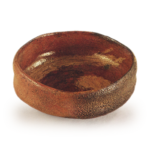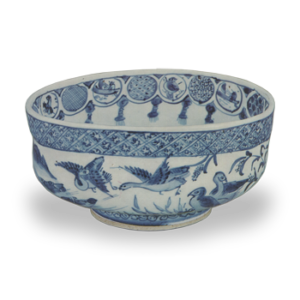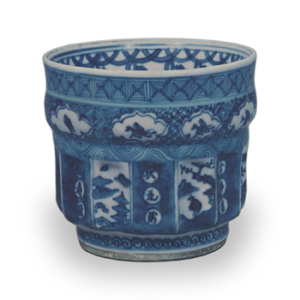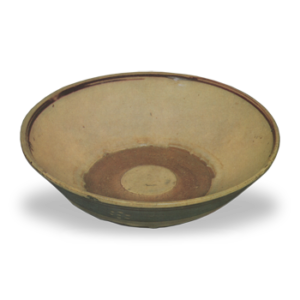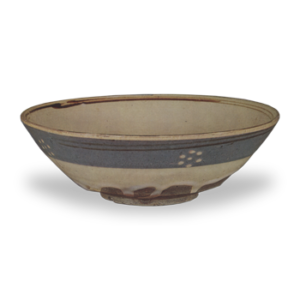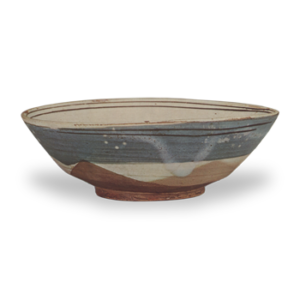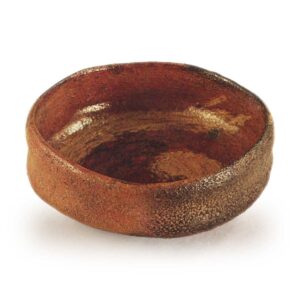
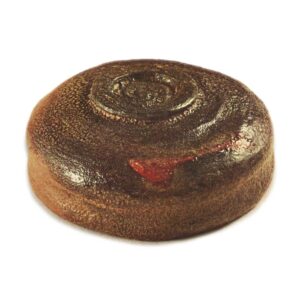
Height: 5.2 – 5.5 cm
Diameter: 13.8 – 14.1 cm
Outer diameter of foot ring: 5.9 – 6.0 cm
Height of foot ring: 0.3 cm
As a Nongou ware bowl, it is a gentle-looking bowl, and its horse-head-shaped flat bowl shape is not original to Nongou, but is a direct copy of the flat bowl style of Chojiro ware. And, as for Nongou, it is probably not a piece from his previous work, as he does not emphasize his characteristic style of making. Also, the glaze is quite crude, and although there is a difference between the red and black, it is not as creative as “Kei” or “Chidori”, and it is not as vivid as “Kore-iro”.
It may be a flat bowl, but the foot is quite low and the waist is well-defined. The body tapers in the middle and the mouth is slightly turned inwards, with a gently raised rim. It is a typical Raku ware flat bowl, but the wide, generous interior shows the distinctive characteristics of Nonko ware.
The red Raku glaze that covers the entire surface is not as glossy as one would expect from a Noko piece, and the glaze is crinkled in places, but the dark green color change that occurs from the foot to the waist is a highlight of this piece. A faint green glaze can also be seen on part of the inside, and on the wide inside, a single brushstroke of white sand is carelessly and vigorously printed, but as this is a flat tea bowl, this single brushstroke design is truly effective, and the reason why this tea bowl has been highly regarded since ancient times is because of this white brushstroke, which is an unprecedented scene for a Raku tea bowl.
The single character “巴” is written in black ink on the front of the inner box lid, and the author is said to be Sen Sōtan. This is the name written in the shape of a “巴” using white brush strokes on the inside of the tea bowl.
On the underside of the lid, there is a handwritten inscription by the second Bunshu of Kankyuan, “Kichibei ware, Hira-aka tea bowl, with the character ‘Tomoe’ written by Sōtan, Sōmori (signature)”, and on the underside of the lid of the outer box on the inside of the lid of the outer box, there is a seal reading “Nonkou Aka-hirabawan Bunsoku Hakogaki Tomohe no Iji Hakogaki Aru Koreha Sotan Fude no Yoshi Soshimori (signature)” written by Nokosai Soshimori. There is also a seal reading “Nonkou Sakuhin Aka-hirabawan Kyudai Ryoui (seal)” on the inside of the lid of the outer box.
It is unusual for Bunshu to refer to Nonkou as “Kichibei-yaki” in his notes, and as Koetsu also refers to him as “Kichibei” in the “Hon’ami Gyojoki” (Hon’ami’s Diary), Kichibei was Nonkou’s common name.
The origin of this tea bowl in the olden days is unknown, but judging from the inscription on the box, it is thought that it was originally owned by Sōtan, and then passed down to the Kankyūan, or Mushanokōji family, and was not passed down to the same family until the time of the second Bunshu and the fourth Naisai, and it is thought that it was passed to another family during the Rōnyū period. Even if this is not the case, it is clear that it was owned by a tea master of the Kankyuan lineage.
After that, it became the property of the Fujita family of Osaka, and was sold to the Toda Honke, a tool dealer in Osaka, at the first auction held by the Fujita family.

